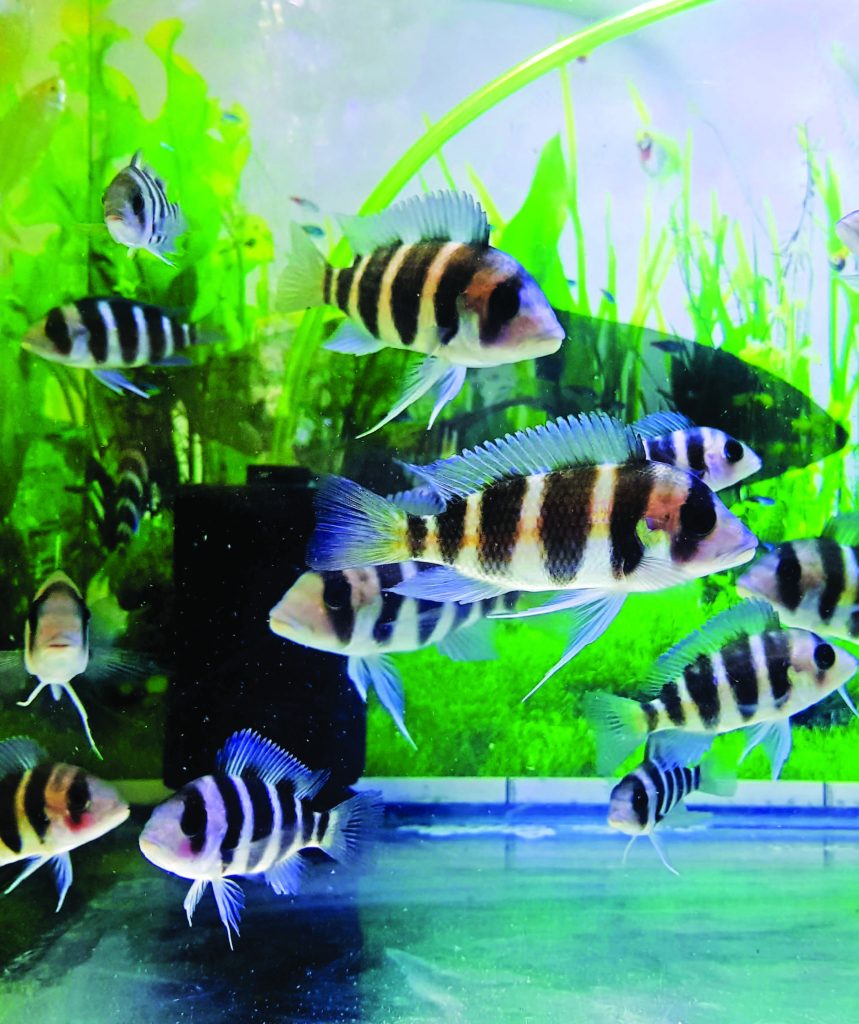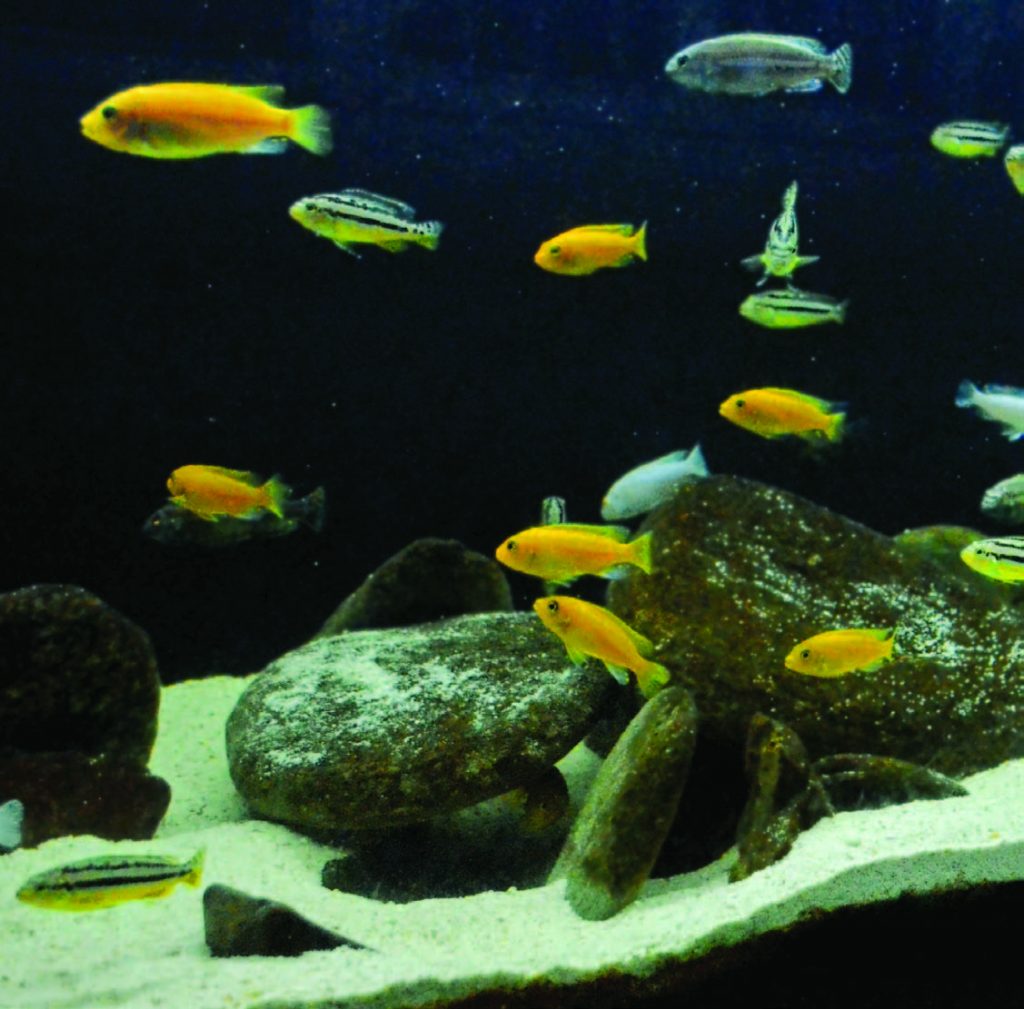They are among the most colorful freshwater fish around, their bold colors and aggressive behavior almost like marine fish. Their home waters have the same pH as saltwater. Even their habitats — wave-pounded rocky shores, shell-littered sand flats and open water patrolled by predators — look eerily like coral reefs.
Animal Scene readers, meet the famed cichlids of Africa’s Great Rift Lakes.

Formed millions of years ago in East Africa’s Rift Valley (where humans originated), three of the planet’s largest lakes occupy a region twice the length of the Philippines. Lakes Victoria, Malawi, and Tanganyika evolved as oases of freshwater diversity in the savanna scrubs of Africa, hosting more cichlid species than any other place on earth. Lake Malawi alone is home to around 15 percent of the planet’s freshwater fish species, nearly all of them endemic.
Well known to both aquarists and fish farmers (tilapia are important food fish), cichlids (SICK-lids) are one of the largest fish groups. Over 1,600 species have been described, with more being discovered annually (there could be well over 3,000 species in all). They range in size from under an inch to over a meter and are found in Africa, the Americas, and parts of Asia.
To aquarists, the most well-known cichlids are probably the graceful striped angelfish of Amazonia — but in terms of color and boldness, Africa’s Rift Lake cichlids reign as kings.
Darwinian evolution in lakes
There are other lakes in Africa’s Rift Valley, like Kenya’s Lake Turkana or Tanzania’s Lake Rukwa, but the three largest host upwards of a thousand cichlid species, a full two-thirds of all known types. Popular fish include the blue-striped Cyphotilapia frontosa, lemon-hued Neolamprologus leleupi longior, and the aggressive yellow-and-black striped Melanochromis auratus.
In the 1830s, naturalist Charles Darwin visited the Galápagos Islands and noticed how a group of birds called finches developed differently-shaped beaks to exploit various ecological niches.

African Rift Lake cichlids evolved similarly, taking complete advantage of their environment. For instance, Tropheus moorii grazes on algae growing on rocks, while Neolamprologus cichlids crush snails and other mollusks with their powerful, flat teeth. Cyprichromis cichlids are planktivores, forming thousands-strong schools high up the water column to snap morsels floating past (like the anthias we see in coral reefs), while Perissodus cichlids evolved to scrape off and eat the scales of other fish!
Mother species
Scientists have postulated that all cichlids from Lake Malawi evolved from a single species inhabiting the lake 700,000 years ago, while those from Lake Victoria were from another cichlid which proliferated 12,000 years ago. The fact that two fish can speciate into almost a thousand in less than a million years has astounded the scientific community and challenged previous notions on how rapidly evolution can happen.
Great potential for evolution
Perhaps the most amazing facet of the Rift Lakes is the speed by which new species evolve. According to a 1999 study by Stiassny and Meyer, Lake Tanganyika formed from nine to 12 million years ago but hosts 200 cichlid species. Lake Victoria formed between 250,000 to 750,000 years ago (but almost completely dried up some 12,000 years ago), yet it hosts over 400 cichlid species. Lake Malawi was born just four million years ago but contains at least 500 cichlid species.
Treasures under threat
Though these three lakes have incredible fish diversity, they are also among the world’s most threatened. Pollution, land conversion, run-off, deforestation, overfishing for both food and the aquarium fish industries, plus the genocidal damage wrought by invasive species are silently eroding the biodiversity of these magnificent freshwater habitats.

In Lake Victoria, the introduction of Nile Perch (Lates niloticus) has proven disastrous. In an attempt to “boost fisheries productivity”, the predatory fish were introduced to the lake in the 1950s. Growing over six feet long, they soon preyed on over 100 other fish species, practically wiping out 60 percent of the lake’s native cichlids in what may be the largest vertebrate extinction of the 20th century. As you read this, thousands of brightly-colored cichlids (some not even known to science) are being eaten hourly by the lake’s Nile Perch, very much like what is happening to Philippine waterways via the introduction of tilapia.
Conservation attempts
So what can hobbyists do to help conserve African Rift Lake cichlids? Best Alternatives, a movement to promote environmental solutions for various industries, recognizes Pinoy cichlid specialists as banner-bearers for the propagation of pureblood strains and color morphs, ensuring that captive-bred fish with undiluted genes are available locally.

Remember that wild-capture fisheries are not necessarily bad, for they sustain the lives and livelihoods of many aquarium fish gatherers in the Rift Valley. However, wild stocks of in-demand species like Tropheus duboisi, Melanochromis chipokae, and especially Chindongo saulosi have already been decimated by collectors.
Lastly, I’ve always believed that the best place to observe fish are in their natural habitats. Those longing to see cichlids in the shallow, sunlit edges of the Rift Lakes can travel to Malawi, Uganda, and Zambia from hubs like Kenya and don either SCUBA or snorkeling gear. It’s one thing to see cichlids in tanks and another to see them where they live, where they breed, and where they are most probably still undergoing their never-ceasing process of evolution.
This appeared in Animal Scene magazine’s January 2019 issue.





